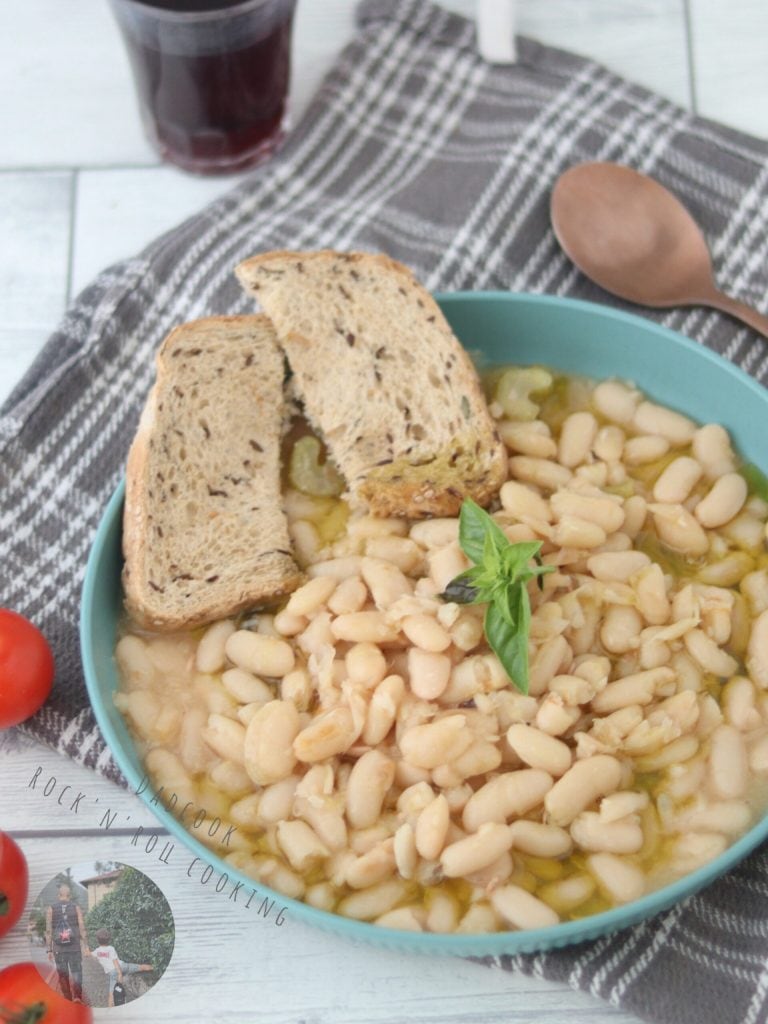Cooking dried beans may seem like a very tedious task for those inexperienced in the kitchen, which is why canned legumes are always used. Nothing against canned legumes, in fact, I buy them too because they are a good product, but preparing legumes as tradition dictates is something else… and flavor! It really takes very little time at the stove to prepare something that tastes of family and love for cooking. The traditional lunch of enjoying this unique dish to share with loved ones is unmatched.
And why not with friends instead of the usual spaghetti? Have you ever prepared pasta and beans for your friends? Let me know in the comments if you want.

- Difficulty: Very Easy
- Cost: Very Cheap
- Rest time: 8 Minutes
- Preparation time: 15 Minutes
- Portions: 6
- Cooking methods: Slow Cooking
- Cuisine: Italian
- Seasonality: All Seasons
- Energy 279.90 (Kcal)
- Carbohydrates 50.47 (g) of which sugars 1.80 (g)
- Proteins 19.50 (g)
- Fat 0.88 (g) of which saturated 0.21 (g)of which unsaturated 0.37 (g)
- Fibers 12.74 (g)
- Sodium 144.93 (mg)
Indicative values for a portion of 90 g processed in an automated way starting from the nutritional information available on the CREA* and FoodData Central** databases. It is not food and / or nutritional advice.
* CREATES Food and Nutrition Research Center: https://www.crea.gov.it/alimenti-e-nutrizione https://www.alimentinutrizione.it ** U.S. Department of Agriculture, Agricultural Research Service. FoodData Central, 2019. https://fdc.nal.usda.gov
Ingredients
- 17.6 oz white beans (cannellini)
- 1 stalk celery
- 1 tomato
- 2 cloves garlic
- A few leaves bay leaves
- 0.07 oz salt
- 6 cups water
- 1 drizzle extra virgin olive oil
Tools
- 1 Terracotta Pot
- 1 Bowl
Steps
First, when we want to boil beans, regardless of the type we have chosen, we must wash them thoroughly and soak them following the instructions on the package if present, or we will follow the seller’s instructions in the case of loose and unpackaged dried legumes.
For this recipe, I chose white cannellini beans.

After soaking the legumes and discarding any beans with imperfections or impurities, I cut a stalk of celery, crushed the garlic, and peeled a tomato to give even more flavor to the cooking water, which we can ultimately use to dress the beans themselves or to cook pasta.

The next step is to add a drizzle of oil to a tall pot, preferably made of terracotta if available, otherwise a common pot, and sauté for a few seconds a drizzle of extra virgin olive oil, garlic, celery, bay leaves, and the peeled tomato.

Then add the beans to the sauté and cover them generously with cold water. Once it boils, let it cook with the lid on for about 60 minutes or until the beans are well-cooked. Everything depends on the type of legume we have chosen and not worrying if the water hasn’t reduced enough. Actually, it’s better to have more as we can reuse it to preserve the legumes or for the uses mentioned before.

Lastly but not least, a few minutes before turning off the gas, I added salt to adjust the seasoning.

Finally, the legumes are ready, and as you can see, I have been generous with the water and cooked the beans over low heat so as not to let it evaporate too much, so I can use it for any recipe I want.
If you are inexperienced and want to know if the beans are cooked without tasting them and risking eating some raw, just stir with a spoon and see if the skin has split open.
This is the proof that the legumes are ready and now, if you want, you can taste and adjust the salt.

By the way, now that we have boiled the beans, we can prepare them however we like to enjoy them, for example, as a first course they are great for making our beloved pasta and beans or another idea is to make the famous and delicious Bud Spencer beans or sausage and beans which I’ve already written about here.
Well, there’s nothing left but to enjoy them as you please and bon appétit from Dadcook!


